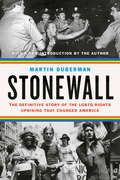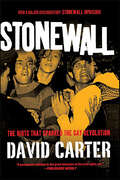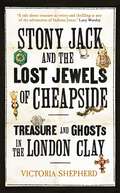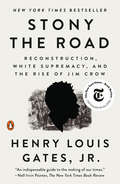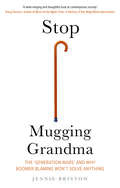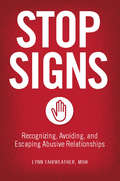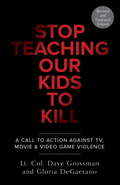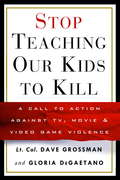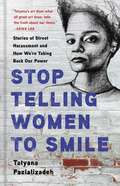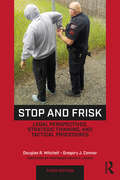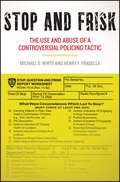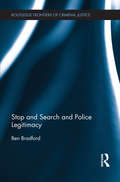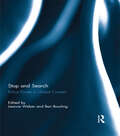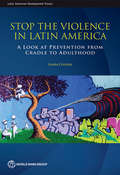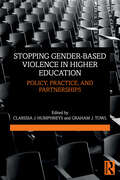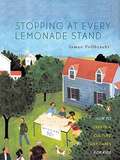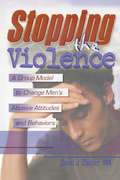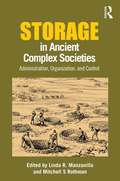- Table View
- List View
Stonewall kommt in die Jahre: Eine feministisch-anerkennungstheoretische Studie zum gelingenden Alter(n) queerer Menschen (Vallendarer Schriften der Pflegewissenschaft #15)
by Kathrin KürstenIm Rahmen dieses Buches wird erforscht, inwiefern sich das Alter(n) von queeren Menschen von dem der heteronormativen Mehrheit unterscheidet und wie ein gelingendes Alter(n) dieser spezifischen Minderheitengruppe gewährleistet werden kann. Die mittels themenzentrierter Interviews erhobenen und anhand einer qualitativen Inhaltsanalyse interpretierten Daten werden vor dem theoretischen Hintergrund der Anerkennungstheorie (Honneth), dem Queer-Feminismus (Butler) und dem Minderheitenstressmodell (Meyer) diskutiert. Zum Abschluss erfolgt eine Proposition einer Theorie zum gelingenden Alter(n) queerer Menschen, die neben einer inhaltlichen Auseinandersetzung auch praktische Empfehlungen für den pflegerischen Alltag anbietet.
Stonewall: The Definitive Story of the LGBT Rights Uprising that Changed America
by Martin DubermanThe definitive account of the Stonewall Riots, the first gay rights march, and the LGBTQ activists at the center of the movement. “Martin Duberman is a national treasure.”—Masha Gessen, The New YorkerOn June 28, 1969, the Stonewall Inn, a gay bar in New York's Greenwich Village, was raided by police. But instead of responding with the typical compliance the NYPD expected, patrons and a growing crowd decided to fight back. The five days of rioting that ensued changed forever the face of gay and lesbian life.In Stonewall, renowned historian and activist Martin Duberman tells the full story of this pivotal moment in history. With riveting narrative skill, he re-creates those revolutionary, sweltering nights in vivid detail through the lives of six people who were drawn into the struggle for LGBTQ rights. Their stories combine to form an unforgettable portrait of the repression that led up to the riots, which culminates when they triumphantly participate in the first gay rights march of 1970, the roots of today's pride marches. Fifty years after the riots, Stonewall remains a rare work that evokes with a human touch an event in history that still profoundly affects life today.
Stonewall: The Riots That Sparked the Gay Revolution
by David CarterDavid Carter's Stonewall is the basis of the PBS American Experience documentary Stonewall Uprising.In 1969, a series of riots over police action against The Stonewall Inn, a gay bar in New York City's Greenwich Village, changed the longtime landscape of the homosexual in society literally overnight. Since then the event itself has become the stuff of legend, with relatively little hard information available on the riots themselves. Now, based on hundreds of interviews, an exhaustive search of public and previously sealed files, and over a decade of intensive research into the history and the topic, Stonewall: The Riots That Sparked the Gay Revolution brings this singular event to vivid life in this, the definitive story of one of history's most singular events. A Randy Shilts / Publishing Triangle Award Finalist"Riveting...Not only the definitive examination of the riots but an absorbing history of pre-Stonewall America, and how the oppression and pent-up rage of those years finally ignited on a hot New York night." - Boston Globe
Stoney Creek Woman
by Bridget MoranThe captivating story of Mary John (who passed away in 2004), a pioneering Carrier Native whose life on the Stoney Creek reserve in central BC is a capsule history of First Nations life from a unique woman's perspective. A mother of twelve, Mary endured much tragedy and heartbreak--the pangs of racism, poverty, and the deaths of six children--but lived her life with extraordinary grace and courage. Years after her death, she continues to be a positive role model for Aboriginals across Canada. In 1997 she received the Order of Canada. This edition of Stoney Creek Woman, one of Arsenal's all-time bestsellers, includes a new preface by author Bridget Moran, and new photographs.Shortlisted for the Roderick Haig-Brown Regional PrizeNow in its 14th printing.
Stony Jack and the Lost Jewels of Cheapside: Treasure and Ghosts in the London Clay
by Victoria ShepherdA thrilling history of mudlarkers, charlatans, experts and chancers – the underbelly of the Edwardian antiques trade. 'What a story! And how skilfully told! A tale about treasure, as twisty and thrilling as any of the adventures of Indiana Jones.' Lucy Worsley June 1912. A pair of workmen deposit a heavy ball of clay in the antiques shop of George Fabian Lawrence, or &‘Stony Jack&’ as he's better known. As Lawrence picks through the mud, a speck of gold catches his eye. A pearl earring tumbles into his hand, then another. A Burmese ruby follows; then Colombian emeralds, lapis lazuli from Afghanistan and turquoise from Iran; tankards; watches; topaz; amazonite. Stony Jack has discovered the greatest single cache of Elizabethan treasure. Diving into London&’s bustling, sometimes lawless, antiques trade at the turn of the century, Victoria Shepherd provides a compelling portrait of the city at the height of empire. A thrilling ride through Edwardian London, from the marble halls of the British Museum to the East End's maze of tenements and alleyways, Stony Jack and the Lost Jewels of Cheapside oversees the transformation of the city into a modern metropolis.
Stony the Road: Reconstruction, White Supremacy, and the Rise of Jim Crow
by Henry Louis GatesA profound new rendering of the struggle by African-Americans for equality after the Civil War and the violent counter-revolution that resubjugated them, as seen through the prism of the war of images and ideas that have left an enduring racist stain on the American mind. <P><P>The abolition of slavery in the aftermath of the Civil War is a familiar story, as is the civil rights revolution that transformed the nation after World War II. But the century in between remains a mystery: if emancipation sparked "a new birth of freedom" in Lincoln's America, why was it necessary to march in Martin Luther King, Jr.'s America? <P><P> In this new book, Henry Louis Gates, Jr., one of our leading chroniclers of the African-American experience, seeks to answer that question in a history that moves from the Reconstruction Era to the "nadir" of the African-American experience under Jim Crow, through to World War I and the Harlem Renaissance. <P><P>Through his close reading of the visual culture of this tragic era, Gates reveals the many faces of Jim Crow and how, together, they reinforced a stark color line between white and black Americans. Bringing a lifetime of wisdom to bear as a scholar, filmmaker, and public intellectual, Gates uncovers the roots of structural racism in our own time, while showing how African Americans after slavery combatted it by articulating a vision of a "New Negro" to force the nation to recognize their humanity and unique contributions to America as it hurtled toward the modern age. <P><P>The story Gates tells begins with great hope, with the Emancipation Proclamation, Union victory, and the liberation of nearly 4 million enslaved African-Americans. Until 1877, the federal government, goaded by the activism of Frederick Douglass and many others, tried at various turns to sustain their new rights. <P><P> But the terror unleashed by white paramilitary groups in the former Confederacy, combined with deteriorating economic conditions and a loss of Northern will, restored "home rule" to the South. The retreat from Reconstruction was followed by one of the most violent periods in our history, with thousands of black people murdered or lynched and many more afflicted by the degrading impositions of Jim Crow segregation. <P><P> An essential tour through one of America's fundamental historical tragedies, Stony the Road is also a story of heroic resistance, as figures such as W. E. B. Du Bois and Ida B. Wells fought to create a counter-narrative, and culture, inside the lion's mouth. As sobering as this tale is, it also has within it the inspiration that comes with encountering the hopes our ancestors advanced against the longest odds. <P><b>A New York Times Bestseller</b>
Stop Acting Rich ... and Start Living like a Real Millionaire
by Thomas J. StanleyIn Stop Acting Rich, Dr. Stanley, uncovers the truth about millionaires' spending habits and unlocks their secrets. The book challenges our perceptions about what being rich is all about and shows us an achievable path to wealth and happiness.
Stop Arguing with Your Kids
by Michael NicholsFor parents fed up with constant challenges to their authority-but who dread becoming tyrants in their own homes-this book provides a powerful new alternative to "because I said so." Trusted family therapist and author Michael P. Nichols takes on the number-one problem of parents today with the insight and humor that has made his earlier The Lost Art of Listening an enduring bestseller. Presented is a simple, easy-to-follow, yet remarkably effective way to put an end to arguments by refusing to argue back. Instead, the techniques of responsive listening help parents open up better communication in the family; create an atmosphere of respect and cooperation; and take children's feelings into account-without giving in to their demands. Loads of realistic examples help parents defuse whining and defiance and manage common conflicts with preschoolers to teens.
Stop Being Niggardly: And Nine Other Things Black People Need to Stop Doing
by Karen Hunternig·gard·ly (adj.) [nig´erd-le]1. stingy, miserly; not generous2. begrudging about spending or granting3. provided in a meanly limited supply If you don't know the definition of the word, you might assume it to be a derogatory insult, a racial slur. You might be personally offended and deeply outraged. You might write an angry editorial or organize a march. You might even find yourself making national headlines In other words, you'd better know what the word means before you pour your energy into overreacting to it. That's the jumping-off point for this powerful directive from Pulitzer Prize-winning journalist and bestselling author Karen Hunter. It's time for the black community to stop marching, quit complaining, roll up their collective sleeves, channel their anger constructively, and start fixing their own problems, she boldly asserts. And while her straight-talking, often politically incorrect narrative is electrifyingly fresh and utterly relevant to today's hot-button issues surrounding race, Hunter harks back to the wisdom of a respected elder--Nannie Helen Burroughs, who was ahead of her time penning Twelve Things the Negro Must Do for Himself more than a century ago. Burroughs's guidelines for successful living--from making education, employment, and home ownership one's priorities to dressing appropriately to practicing faith in everyday life--teach empowerment through self-responsibility, disallowing excuses for one's standing in life but rather galvanizing blacks to look to themselves for strength, motivation, support, and encouragement. From our urban communities to small-town America, the issues Hunter is bold enough to tackle in Stop Being Niggardly affect us all. Refreshingly candid and challenging, certain to get people everywhere talking, this is the book that takes on race in a new--yet also historically revered and simply stated--way that can change lives, both personally and collectively.
Stop Mugging Grandma: The 'Generation Wars' and Why Boomer Blaming Won't Solve Anything
by Jennie BristowA decisive intervention in the "war" between generations, asking who stands to gain from conflict between baby boomers and millennials Millennials have been incited to regard their parents’ generation as entitled and selfish, and to blame the baby boomers of the Sixties for the cultural and economic problems of today. But is it true that young people have been victimized by their elders? In this book, Jennie Bristow looks at generational labels and the groups of people they apply to. Bristow argues that the prominence and popularity of terms like "baby boomer," "millennial," and "snowflake" in mainstream media operates as a smoke screen—directing attention away from important issues such as housing, education, pensions, and employment. Bristow systematically disputes the myths that surround the "generational war," exposing it to be nothing more than a tool by which the political and social elite can avoid public scrutiny. With her lively and engaging style, Bristow highlights the major issues and concerns surrounding the sociological blame game.
Stop Signs: Recognizing, Avoiding, and Escaping Abusive Relationships
by Lynn FairweatherMost abusers display warning signs that intelligent women miss-mostly because the majority of women have not been trained to recognize them. In this groundbreaking book, Lynn Fairweather-an expert in the field of intimate partner violence response and prevention-provides women with the information they need to recognize dangerous menbeforethey become victims of abuse. Educational and empowering,Stop Signsexposes the discernable attributes, tactics, and deterrents of abusers, arming women with the tools they need to choose a safe and loving partner. In the first section, Fairweather familiarizes readers with the topic of intimate partner violence and explains how to develop the combination of self-esteem, preparation, and assertive awareness that can protect women from involvement with abusive individuals; in the second section, she explores the minds of abusers, explaining what visible signs of danger are present in their attitudes and actions; and in the last section, she provides women with effective strategies for safe extraction should they find themselves involved with an abuser. A go-to manual for women everywhere,Stop Signscontains the life-saving information needed by anyone who is living with abuse, knows someone who is, or wishes to avoid becoming involved in a potentially life-threatening relationship.
Stop Teaching Our Kids To Kill, Revised and Updated Edition
by Gloria Degaetano Lt. Col. Dave GrossmanCompletely revised and updated, a much-needed call to action for every parent, teacher, and citizen to help our children and stop the wave of killing and violence gripping America's youth Newtown, Aurora, Virginia Tech, Columbine. Thereis no bigger or more important issue in America than youth violence. Kids, some as young as ten years old, take up arms with the intention to murder. Why is this happening? Lt. Col. Dave Grossman and Gloria DeGaetano believe the root cause is the steady diet of violent entertainment kids see on TV, in movies, and in the video games they play--witnessing hundreds of violent images a day. Offering incontrovertible evidence based on recent scientific studies and research, they posit that this media is not just conditioning children to be violent and see killing as acceptable but teaching them the mechanics of killing as well. Stop Teaching Our Kids to Kill supplies the statistics, interprets the copious research that exists on the subject, and suggests the many ways to make a difference in your home, at school, in your community, in the courts, and in the larger world. In using this book, parents, educators, social-service workers, youth advocates, and anyone interested in the welfare of our children will have a solid foundation for effective action and prevention of future Columbines, Jonesboros, and Newtowns.
Stop Teaching Our Kids to Kill: A Call to Action Against TV, Movie & Video Game Violence
by Gloria Degaetano Dave GrossmanThere is perhaps no bigger or more important issue in America at present than youth violence. Jonesboro; Paducah; Pearl, Mississippi; Stamps, Arkansas; Conyers, Georgia; and, of course, Littleton, Colorado. We know them all too well, and for all the wrong reasons: kids, some as young as eleven years old, taking up arms and, with deadly, frightening accuracy, murdering anyone in their paths. What is going on? According to the authors of Stop Teaching Our Kids to Kill, there is blame to be laid right at the feet of the makers of violent video games (called "murder trainers" by one expert), the TV networks, and the Hollywood movie studios--the people responsible for the fact that children witness literally thousands of violent images a day. Authors Lt. Col. Dave Grossman and Gloria DeGaetano offer incontrovertible evidence, much of it based on recent major scientific studies and empirical research, that movies, TV, and video games are not just conditioning children to be violent--and unaware of the consequences of that violence--but are teaching the very mechanics of killing. Their book is a much-needed call to action for every parent, teacher, and citizen to help our children and stop the wave of killing and violence gripping America's youth. And, most important, it is a blueprint for us all on how that can be achieved. In Paducah, Kentucky, Michael Carneal, a fourteen-year-old boy who stole a gun from a neighbor's house, brought it to school and fired eight shots at a student prayer group as they were breaking up. Prior to this event, he had never shot a real gun before. Of the eight shots he fired, he had eight hits on eight different kids. Five were head shots, the other three upper torso. The result was three dead, one paralyzed for life. The FBI says that the average, experienced, qualified law enforcement officer, in the average shootout, at an average range of seven yards, hits with less than one bullet in five. How does a child acquire such killing ability? What would lead him to go out and commit such a horrific act?
Stop Telling Women to Smile: Stories of Street Harassment and How We're Taking Back Our Power
by Tatyana Fazlalizadehp.p1 {margin: 0.0px 0.0px 10.0px 0.0px; font: 12.0px 'Times New Roman'} p.p2 {margin: 0.0px 0.0px 0.0px 0.0px; font: 12.0px 'Times New Roman'} p.p3 {margin: 0.0px 0.0px 0.0px 0.0px; font: 12.0px 'Times New Roman'; min-height: 15.0px} The debut book from a celebrated artist on the urgent topic of street harassmentEvery day, all over the world, women are catcalled and denigrated simply for walking down the street. Boys will be boys, women have been told for generations, ignore it, shrug it off, take it as a compliment. But the harassment has real consequences for women: in the fear it instills and the shame they are made to feel. In Stop Telling Women to Smile, Tatyana Fazlalizadeh uses her arresting street art portraits to explore how women experience hostility in communities that are supposed to be homes. She addresses the pervasiveness of street harassment, its effects, and the kinds of activism that can serve to counter it. The result is a cathartic reckoning with the aggression women endure, and an examination of what equality truly entails.
Stop Whining, Start Living
by Dr Laura SchlessingerLiving life is about action: courageous, benevolent, worthy, Wise, and productive action. Start living with some help from Dr. Laura Schlessinger.Dr. Laura Schlessinger agrees that there are things worth whining about. A certain amount of whining allows for venting of reasonable pain, disappointment, fear, frustration, or rage. However, staying stuck in whining mode can become a lifelong problem. This is where Dr. Laura steps in with Stop Whining, Start Living to help folks conquer the temptation to retreat from living life to the fullest.Illustrated by calls and letters from members of Dr. Laura's huge international audience, Stop Whining, Start Living features testimonials from real people facing real challenges. These folks have benefited enormously from Dr. Laura's powerful lessons.Stop Whining, Start Living gives readers the jump start they need to break out of reactive mode and get proactive, moving in the direction of a joyful, meaningful, fulfilling, and purposeful future. Everyone can use a kick in the pants sometimes, and Dr. Laura, who "preaches, teaches, and nags" to millions every day on her radio program, is here to deliver it!
Stop Whining, Start Living
by Laura SchlessingerLiving life is about action: courageous, benevolent, worthy, Wise, and productive action. Start living with some help from Dr. Laura Schlessinger. Dr. Laura Schlessinger agrees that there are things worth whining about. A certain amount of whining allows for venting of reasonable pain, disappointment, fear, frustration, or rage. However, staying stuck in whining mode can become a lifelong problem. This is where Dr. Laura steps in with Stop Whining, Start Living to help folks conquer the temptation to retreat from living life to the fullest. Illustrated by calls and letters from members of Dr. Laura's huge international audience, Stop Whining, Start Living features testimonials from real people facing real challenges. These folks have benefited enormously from Dr. Laura's powerful lessons. Stop Whining, Start Living gives readers the jump start they need to break out of reactive mode and get proactive, moving in the direction of a joyful, meaningful, fulfilling, and purposeful future. Everyone can use a kick in the pants sometimes, and Dr. Laura, who "preaches, teaches, and nags" to millions every day on her radio program, is here to deliver it!
Stop and Frisk: Legal Perspectives, Strategic Thinking, and Tactical Procedures
by Douglas R. Mitchell Gregory J. ConnorEvery law enforcement patrol officer and investigator needs to understand both the tactical considerations of stopping and frisking a suspect, and the legal constraints that should govern that power. Recent years have shown clearly the damage that can be done when police lack an adequate understanding of the legal foundation for their activities. In this new edition of Stop and Frisk, Mitchell and Connor team up to provide active or aspiring police officers with the knowledge of applicable law as well as practical techniques they need to safely and legally carry out their crime suppression and investigative duties. This updated edition includes clear summaries of major cases of the last decade and lessons learned when police and communities failed to fully understand the results of Terry v. Ohio. Ideal for in-service training at the post-academy level, this book also gives time-tested tools to police officers, supervisors, and legal advisors. Stop and Frisk can be used to teach undergraduate Criminal Justice majors as well as concerned citizens to prevent crime in their communities.
Stop and Frisk: The Use and Abuse of a Controversial Policing Tactic
by Michael D. White Henry F. FradellaWinner, 2019 Outstanding Book Award, given by the American Society of Criminology’s Division of Policing SectionThe first in-depth history and analysis of a much-abused policing policyNo policing tactic has been more controversial than “stop and frisk,” whereby police officers stop, question and frisk ordinary citizens, who they may view as potential suspects, on the streets. As Michael White and Hank Fradella show in Stop and Frisk, the first authoritative history and analysis of this tactic, there is a disconnect between our everyday understanding and the historical and legal foundations for this policing strategy. First ruled constitutional in 1968, stop and frisk would go on to become a central tactic of modern day policing, particularly by the New York City Police Department. By 2011 the NYPD recorded 685,000 ‘stop-question-and-frisk’ interactions with citizens; yet, in 2013, a landmark decision ruled that the police had over- and mis-used this tactic. Stop and Frisk tells the story of how and why this happened, and offers ways that police departments can better serve their citizens. They also offer a convincing argument that stop and frisk did not contribute as greatly to the drop in New York’s crime rates as many proponents, like former NYPD Police Commissioner Ray Kelly and Mayor Michael Bloomberg, have argued. While much of the book focuses on the NYPD’s use of stop and frisk, examples are also shown from police departments around the country, including Philadelphia, Baltimore, Chicago, Newark and Detroit. White and Fradella argue that not only does stop and frisk have a legal place in 21st-century policing but also that it can be judiciously used to help deter crime in a way that respects the rights and needs of citizens. They also offer insight into the history of racial injustice that has all too often been a feature of American policing’s history and propose concrete strategies that every police department can follow to improve the way they police. A hard-hitting yet nuanced analysis, Stop and Frisk shows how the tactic can be a just act of policing and, in turn, shows how to police in the best interest of citizens.
Stop and Search and Police Legitimacy (Routledge Frontiers of Criminal Justice)
by Ben Bradford‘Stop and search’ is a form of police-citizen interaction that is confrontational, often stressful for those involved, and potentially damaging to the relationship between police and public. The extent to which police officers use their power to stop and perhaps search members of the public is intimately linked not only to the present-day context of policing but also to longer term patterns in the aims of policing, the ends used to achieve them, and ultimately to the ideology of policing in England and Wales. Stop and Search and Police Legitimacy draws upon both police-administrative and survey-based data to examine what has for many years been one of the most highly charged and contested aspects of police practice. Taking a decidedly quantitative, empirical, approach, this book examines the patterning of police stops over social and geographic space, the problem of ethnic disproportionality, and the evidence concerning how people experience and react to being stopped by police – particularly in relation to issues of fairness, legitimacy, cooperation and compliance. A further important concern is the extent to which this form of police practice shapes and re-shapes the identities of those affected by it. This ground-breaking study is a comprehensive resource for students and scholars in the fields of criminology, sociology, social policy, ethnic and racial studies and human rights. It will also be of special interest to police leaders and policy-makers.
Stop and Search: Police Power in Global Context
by Ben Bowling Leanne WeberPolice powers to stop, question and search people in public places, and the way these powers are exercised, is a contentious aspect of police-community relations, and a key issue for criminological and policing scholarship, and for public debate about liberty and security more generally. Whilst monitoring and controlling minority populations has always been a feature of police work, new fears, new ‘suspect populations’ and new powers intended to control them have arisen in the face of instability associated with rapid global change. This book synthesises and extends knowledge about stop and search practices across a range of jurisdictions and contexts. It explores the use of stop and search powers in relation to street crime, terrorism and unauthorised migration in Britain, North America, Europe, Australia, Africa, and Asia. The book covers little researched practices such as road-blocks and ID checking, and discusses issues such as fairness, effectiveness, equity and racial profiling. It provides a substantive and theoretical foundation for transnational and comparative research on police powers in a global context. This book was originally published as a special issue of Policing and Society.
Stop the Violence in Latin America: A Look at Prevention from Cradle to Adulthood
by Laura ChiodaThe Latin America and Caribbean (LAC) region has the undesirable distinction of being the world's most violent region, with 24.7 homicides per 100,000 inhabitants. The magnitude of the problem is staggering and persistent. Of the top 50 most violent cities in the world, 42 are in LAC. In 2010 alone, 142,302 people in LAC fell victim to homicide, representing 390 homicides per day and 4.06 homicides every 15 minutes. Crime disproportionately affects young men aged 20 to 24, whose homicide rate of 92 per 100,000 nearly quadruples that of the region. The focus of Crime Prevention in Latin America and the Caribben is to identify policy interventions that, whether by design or indirect effect, have been shown to affect antisocial behavior early in life and patterns of criminal offending in youth and adults. Particular attention is devoted to recent studies that rigorously establish a causal link between the interventions in question and outcomes. This publication adopts a lifecycle perspective and argues that as individuals progress through different stages of the lifecycle, not only do different sets of risk factors arise and take more prominence, but their interactions and interdependencies shape human behavior. These interactions and the relative importance of different sets of risk factors identify relevant margins that can effectively be targeted by prevention policies, not only early in life, but throughout the lifecycle. Indeed prevention can never start too early, nor start too late, nor be too comprehensive.
Stopping Gender-based Violence in Higher Education: Policy, Practice, and Partnerships
by Graham J. Towl Clarissa J. HumphreysStopping Gender-based Violence in Higher Education provides a unique insight into how gender-based violence at universities is impacting students and staff and outlines the path toward tangible changes that can prevent it. Bringing together perspectives from academics, activists, practitioners, and university administrators, the book presents a diverse range of voices to constructively critique the field. Structured in three parts, the book begins by addressing the context, theory, and law that stipulates how universities can effectively respond to reports of gender-based violence. It goes on to discuss the most pragmatic ways to address the issue while contributing to prevention and supporting victim-survivors. Finally, the book advocates for the development of beneficial working partnerships with key external services available to university communities and also working with students as partners in an ethical and safe way. Throughout the book, contributors are invited to demonstrate a comprehensive institution-wide and trauma-informed approach to centre the needs of the victim-survivor and prioritize resources to undertake this vital work. Each chapter ends with a brief summary of key points or recommendations and suggested further reading on the chapter topic. Although the authors draw on research and policy from the UK Higher Education sector, the insights will be a useful resource for those in universities around the world. This book is an essential reference point and resource for professionals, academics, and students in Higher Education, as well as indispensable reading for activists, policymakers, police, rape crisis groups, and other organisations supporting these universities who want to make meaningful change in reducing, responding to, and preventing gender-based violence in Higher Education.
Stopping at Every Lemonade Stand
by James VollbrachtChildren's lives today are complex, stressful, and dangerous. Kids are overscheduled, come home to empty houses and neighborhoods where they don't know a soul, and in school, face violence-all too often from their peers. In Stopping at Every Lemonade Stand, James Vollbracht provides a blueprint for transforming our unstable and disconnected culture into a healthier, supportive one. Vollbracht bases his approach on six overlapping circles of community-our personal circle, families, neighborhoods, larger communities, business worlds, and elders-and outlines simple actions within each circle that will help rescue our kids. Through a rich blend of heartwarming anecdotes and creative, practical strategies, Stopping at Every Lemonade Stand affirms the age-old wisdom that the power and responsibility to heal our communities rest in our own hands.
Stopping the Violence: A Group Model to Change Men's Abusive Attitudes and Behaviors
by David J DeckerHelp men learn to change abusive behavior! Stopping the Violence: A Group Model to Change Men&’s Abusive Attitudes and Behaviors helps practitioners reduce the negative atmosphere in a batterers&’ group for men while adapting to clients&’ individual needs, abilities, and levels of motivation. Useful in any type of patient setting, this comprehensive, hands-on guide provides a complete, step-by-step model for a batterer program that includes all of the forms, handouts, tools, and assignments necessary for the treatment process. Pro-feminist, cognitive, and behavioral in its orientation, this program works to eliminate the mindset that dominates, controls, and leads to the battering of women. The focus throughout the treatment process described in Stopping the Violence is not only on ending physical violence, but addressing what causes it. The exercises and suggestions in this program will teach your clients how emotional abuse, verbal abuse, substance abuse problems, mental health issues, and entitled and controlling attitudes contribute to and lead to battering. You will also find methods to help clients learn to take responsibility for their actions and discover if their childhoods have had an impact on their assumption of patriarchal and controlling attitudes. In addition, Stopping the Violence offers exercises on building self-confidence, self-esteem, self-control, and emotional support for your clients. This guide offers other valuable suggestions and exercises, such as: an explanation of 12 educational units to be presented by the therapist, including such topics as abuse and its effects, anger regulation, stress management, shame and empowerment, assertiveness, communication, and conflict resolution showing the client how to and why he should develop an increased realization of the impact of his abuse assisting the client in learning to monitor his internal and external escalation-to-violence cues creating a supportive group atmosphere that will decrease men&’s shame and isolation and increase their ability to feel empathy for themselves and others providing a reading list with additional resources that clients can use to enhance their treatment Vital to any batterers&’ treatment that is starting or already exists, Stopping the Violence will help you teach your clients how they can find pride as nonabusive men in a society full of patriarchal values, as well as teach them to be in control of themselves-not their partners or their children. This guide will help you identify and change your clients&’ abusive behaviors and successfully show them how abusive behavior is hurtful and destructive for everyone involved.
Storage in Ancient Complex Societies: Administration, Organization, and Control
by Linda R. Manzanilla Mitchell RothmanThe ability to accumulate and store large amounts of goods is a key feature of complex societies in ancient times. Storage strategies reflect the broader economic and political organization of a society and changes in the development of control mechanisms in both administrative and non-administrative—often kinship based—sectors. This is the first volume to examine storage practices in ancient complex societies from a comparative perspective. This volume includes 14 original papers by leading archaeologists from four continents which compare storage systems in three key regions with lengthy traditions of complexity: the ancient Near East, Mesoamerica, and Andes. Storage in Ancient Complex Societies demonstrates the importance of understanding storage for the study of cultural evolution.

